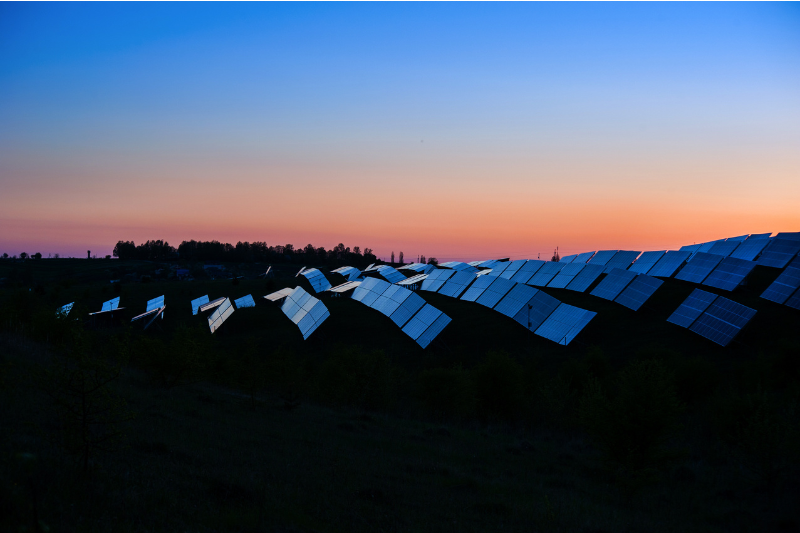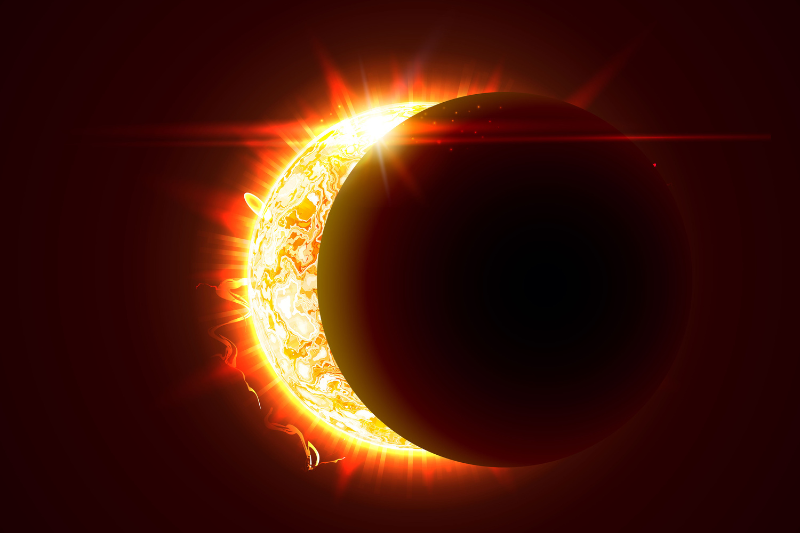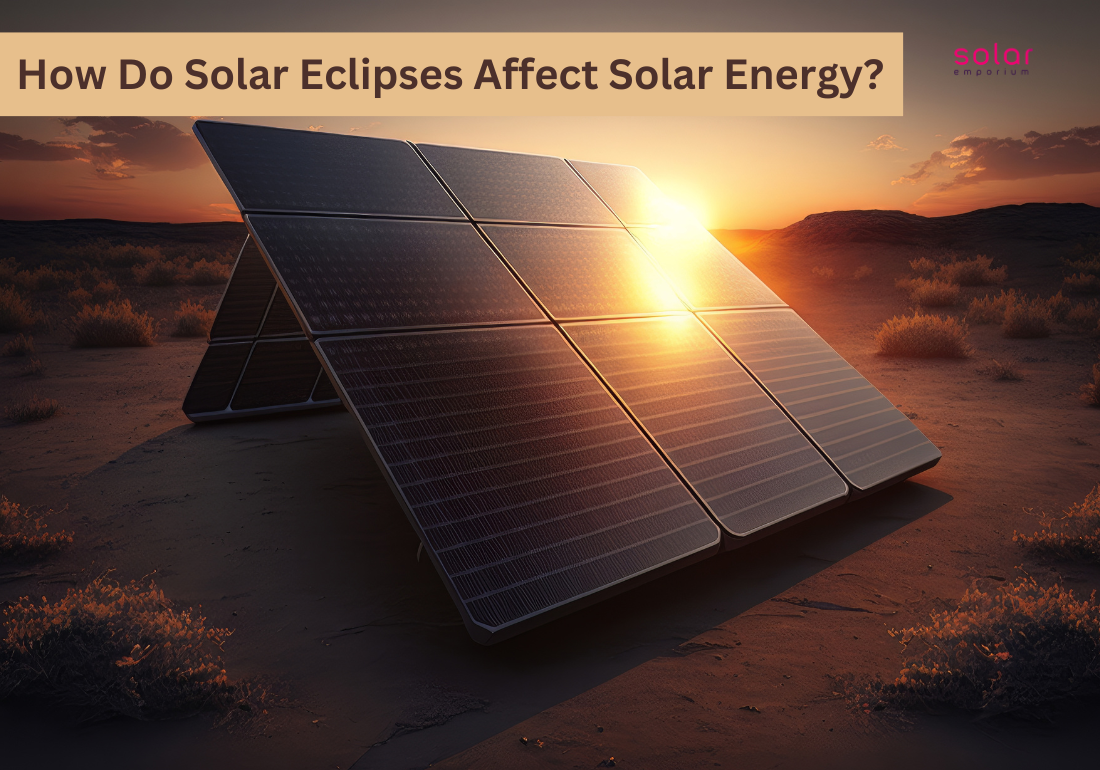On April 20, 2023, Australia and parts of Southeast Asia experienced an extraordinary solar eclipse that has captivated the interest of both solar and weather enthusiasts.
This occurrence is a unique hybrid solar eclipse. It is a rare celestial event that alternates between an annular and a total solar eclipse along its trajectory.
So, what are eclipses? And how do solar eclipses affect solar energy?
In specific regions, observers witnessed a total solar eclipse. In contrast, others observed an annular solar eclipse characterised by the Moon partially concealing the Sun and creating a visible “ring of fire.”
Here at Solar Emporium, we are enthusiastic about this rare celestial phenomenon. Not only does it provide a spectacular demonstration of the vastness of celestial bodies, but it also has implications for the irradiance levels throughout the day.
This blog post will explore the scientific aspects of hybrid solar eclipses. We will elaborate on how solar eclipses impact solar energy. And discuss solar irradiance and the potential ramifications for the power grid in Australia.
What is A Solar Eclipse, and How Often Do They Happen?
A solar eclipse happens when a new moon lines up perfectly between the Earth and the sun, creating a shadow on our planet called an umbra.
The moon’s size and distance from Earth make it big enough to cover the sun’s disk, partially or entirely, depending on the distance between these three celestial bodies.
On average, a total eclipse, where the moon completely blocks the sun, occurs approximately every one or two years.
Partial solar eclipses happen more frequently when the moon covers only part of the sun.
There are other eclipses, such as annual eclipses. It’s an eclipse with a circle of light around the moon. And there are rare hybrid eclipses, where an eclipse changes from annular to total. Annual eclipses happen because the moon’s orbit around the Earth is not a perfect circle, so its distance varies with each orbital cycle.
Understanding Solar Energy

Solar energy is a power source that comes from the Sun. Typically, the Sun’s light reaches the Earth, and we use that light to generate electricity through solar panels.
However, during a solar eclipse, the Moon moves between the Earth and the Sun, blocking some sunlight for a little while.
This temporary blockage affects solar power generation. When the Moon covers part of the Sun, less sunlight reaches solar panels on Earth.
It means they produce less electricity during the eclipse. It’s like a brief dimming of the Sun’s power.
In places where solar power is a big part of the energy supply, like in Australia, this reduction in sunlight during an eclipse can impact the amount of electricity generated.
However, experts usually plan for this and have ways to manage it. They might use other power sources or have backup plans to ensure enough electricity for everyone.
A solar eclipse is like an interruption in the usual flow of solar energy, but it’s something that energy experts can handle to keep our power supply stable.
How Solar Eclipses Affect Irradiance
Solar eclipses occur when the Moon comes between the Earth and the Sun. It temporarily blocks a portion of the Sun’s light.
When there’s an eclipse, the sunlight from space, called extraterrestrial irradiance, gets less because the Moon covers part of the Sun.
This reduced sunlight goes through the air and clouds, making even less sunlight reach the Earth’s surface during the eclipse. So, there’s not as much solar energy during that time.
The connection between solar eclipses and irradiance appears straightforward until atmospheric conditions and calculations are considered.
How Do We Figure Out the Impact on Solar Power When Solar Eclipses Occur?
To understand how a solar eclipse affects sunlight, we must predict which part of the Sun will be covered. We do this by observing where the Sun and Moon are in the sky from a specific location.
We then figure out how much they overlap. Checking the area of the Sun and Moon for every single question would take a lot of computing power.
So, we focus on the time and places impacted by the eclipse. This way, we can quickly answer questions for all our users.
This approach needs a model that can calculate where the Sun and Moon are based on a person’s latitude and longitude. The model uses algorithms that consider the tilt of the Earth’s orbit, the shape of its path, and how its axis moves over time.
How Did the Eclipse Affect the Power Grid?
When there’s a solar eclipse, it reduces the amount of sunlight. This year’s eclipse also affected solar energy generation, especially in Western Australia.
Since solar energy decreases during the eclipse, the grid must compensate for this temporary loss.
Knowing and predicting how much this will impact the power grid is essential for energy providers and operators to keep the power supply stable and reliable.
Because there’s less solar power during the eclipse, grid operators and energy providers should prepare for extra strain on regular power plants or energy storage systems.
Making accurate predictions about how the eclipse will affect solar power helps these companies plan how to manage energy and avoid any problems with the power supply.
This temporary drop in solar power shows why having different types of energy and sound energy storage is essential.
Using various renewable energy sources, like wind, hydropower, and good solar batteries, grid operators can ensure the power supply stays reliable and steady during events like solar eclipses.
Having accurate forecasts about drops in sunlight, whether because of the weather or events in space like an eclipse, is crucial for operators of solar battery storage systems.
It helps them understand how much energy to expect from renewable energy sources.
Solar Battery Storage Plays an Important Role During a Solar Eclipse

Battery storage plays a crucial role when a solar eclipse occurs. During a solar eclipse, the Moon moves between the Earth and the Sun, temporarily reducing or blocking sunlight.
This reduction in sunlight affects solar power generation, decreasing electricity production from solar panels.
Battery storage systems become particularly important to maintain a stable power supply during this period.
Here’s how battery storage helps during a solar eclipse:
1. Energy Storage:
2. Grid Stability:
3. Smooth Transition:
4. Backup Power:
5. Load Management:
Solar battery systems can strategically manage energy loads during the eclipse. By releasing stored energy during peak demand periods, they contribute to grid stability and help meet electricity needs.
In summary, battery storage is crucial to the overall energy infrastructure during a solar eclipse. It helps bridge the gap between fluctuating solar power production and consistent electricity demand, ensuring a reliable and uninterrupted power supply for consumers.
Australian Government Policies for Rooftop Solar Installation
Australian government policies regarding rooftop solar panel installation are in place.
Here are some general aspects of Australian government policies related to rooftop solar:
1. Solar Rebates and Incentives:
The Australian government and some state and territory governments have offered various rebates and incentives to encourage the installation of rooftop solar panels.
These incentives may include Small-scale Technology Certificates (STCs) or Solar Credits, which can significantly reduce the upfront cost of installing solar systems.
2. Feed-in Tariffs (FiTs):
3. Renewable Energy Targets:
4. Solar Homes Programs:
5. Regulations and Standards:
6. Solar and Battery Storage:
Some government policies may extend to support the integration of solar panels with energy storage systems, such as home battery storage. This is seen as a way to enhance the reliability and stability of the power grid.
The Clean Energy Council and the Australian government’s official websites have the most up-to-date and accurate information on rooftop solar policies.
Additionally, specific guidelines can vary by state and territory, so it’s important to consider regional regulations and incentives. Read about this on our detailed blog, the best solar rebate and incentive guide for Australia







